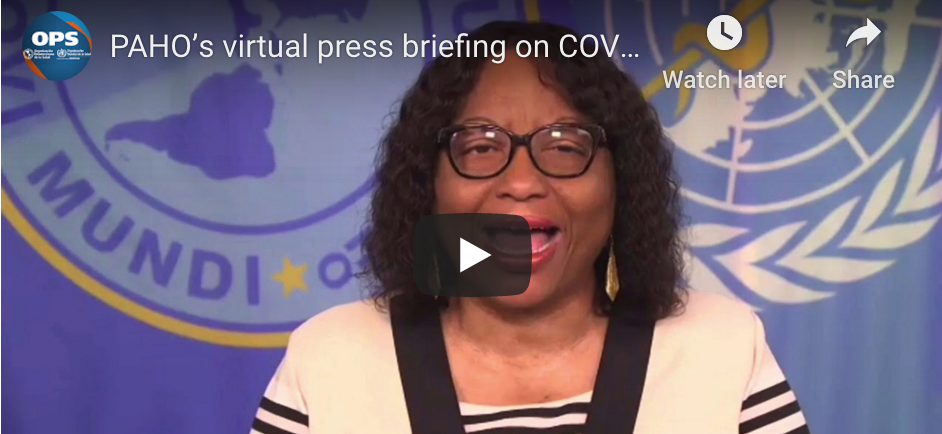PAHO: Director’s Remarks – Weekly Press Briefing on COVID-19 – August 4

Thank you and a very good morning to all of you and thank you for joining today’s press briefing.
Our region remains under the tight grip of this pandemic. As of August 3, the Americas had over 9.7 million cases and over 365,000 deaths – and these numbers continue to rise.
Nearly every country in Mesoamerica is witnessing spikes in COVID-19 cases, with many countries grappling to manage the spikes. Across the Caribbean, countries have managed to control their initial outbreaks, but most have recorded new cases and must remain vigilant, as they reopen their borders and face tropical storms.
There is an overall increasing trend in the Andean subregion and in Brazil. Chile presented a big peak in the May/June time-period and has been declining since. Argentina, however, is reporting an increase in less-populated provinces outside of the capital, Buenos Aires.
Latin America is facing a public health paradox: many countries are reporting record numbers of new infections – a clear sign that the virus is still rapidly spreading – yet, there’s mounting pressure to open economies and schools and continue life as usual.
COVID-19 will not go away any time soon. This pandemic is a reality that we need to adjust to, by continuing to actively implement measures to control the virus, and by using data about the virus spread and the state of our health systems to calibrate our actions.
The pandemic is also not the only health issue that we face. We are beginning to see warning signs of the devastating impact the pandemic has had on other diseases.
We know from experience that natural disasters and health emergencies can fracture and quickly overwhelm health systems, often with grave consequences.
During the recent Ebola outbreak in the Democratic Republic of Congo, the health system struggled to contain the over six thousand Ebola cases that were spreading across the country, and as a result, other services were deprioritized and scaled down. As a result of the disruptions in the vaccination program, 340,000 children were infected with measles.
And the impact of these disruptions can last months or even years. Looking closer to home, in the months following Hurricane Maria, Puerto Rico reported significantly higher death rates than previous years.
Today, we are at risk of history repeating itself.
Within every country in our region, health workers are being redirected to care for the influx of COVID-19 patients. Many of them have gotten sick themselves as they tend to those in need. And without doctors and nurses available to offer other essential services at the first level of care – such as pregnancy-related care, and management of chronic conditions like diabetes or infectious diseases such as HIV, TB and malaria – these services are severely disrupted or worse yet, halted entirely.
At the same time, patients who are sick or who think they might be sick, are hesitant to seek care for fear of COVID-19 infection or because transportation disruptions and lockdowns have made it harder to reach their local clinics. Some may even assume that care is not available and postpone the help they need, often worsening their health situation.
Additionally, our clinics and hospitals are still struggling to stock their shelves with the medicines and personal protective equipment that they need, as the pandemic has strained global supply chains and slowed global trade.
Today, 11 countries within the Americas have less than three-month supply of antiretrovirals. If these are not replenished soon, people living with HIV may have to interrupt their treatment. Meanwhile some countries will run out of tuberculosis medications within the next three months, and the reagents they need to diagnose TB in half of that time. Running out of these supplies is simply not an option – we cannot allow this to happen.
We don’t yet know the full extent of the problem because disease surveillance has been severely disrupted also across more than half of our region due to a lack of lab capacity, supplies and/or personnel.
PAHO is continuously monitoring the situation, and the data we do have is of growing concern.
We conducted a survey with 27 countries that shows that half of diabetes programs and those designed to manage hypertension have been halted at the primary care level. In selected countries, pregnancy-related visits are down by 40% compared to the previous year, increasing the risks for pregnant mothers and their babies.
Currently, there is a measles outbreak in Brazil and we are monitoring cases of diphtheria in Haiti and Venezuela, reminding us that protection against these vaccine-preventable diseases is more important than ever. And yet, more than a quarter of countries have suspended routine vaccination campaigns.
We are also concerned about immunization levels. Our region was the first to eliminate polio and smallpox, a fact that we are very proud of We have the tools and the experience to maintain the highest levels of vaccine coverage, but weeks or months of disruption will increase the risk of outbreaks of vaccine-preventable diseases, reversing our longstanding trends in the Region.
A prolonged response to this pandemic must include the provision of other essential, life-saving services. Countries must avoid thinking that they must make a choice, a choice between reopening economies and protecting the health and well-being of their people.
Countries must adapt and commit to simultaneously providing these essential primary care services while at the same time mitigating the effects of COVID-19. Again, this is not an either/or choice – rather Governments must strike that careful balance for public health.
National leadership must create the pathway for the future. Over the last few months, PAHO has shared best practices and worked hand-in-hand with governments to make adjustments – whether big or small – to be able to do just that.
There are two things every country must do: reengineer how essential care is delivered and invest in the first level of care.
We are seeing many health systems embrace digital health, including telemedicine, so patients can continue to be monitored by providers from the comfort — and safety — of their own homes. In places where telehealth is not available, at-home visits and community outreach programs are supporting our most vulnerable populations.
Our clinics and hospitals are drastically changing their routine by spacing out appointments and allocating specific areas or sometimes even entire floors to care for patients exhibiting COVID-19 symptoms so everyone else can safely receive medical attention without risking infection.
While these small changes are important in the short term, this pandemic has clearly shown that significant investments in our health systems are long overdue and I just say desperately needed.
As PAHO has said before: Now is the time for countries to dedicate 6% of GDP to strengthen their health systems. And the best, and most efficient way to do this, is by prioritizing the first level of care.
If well resourced, primary health care can bring nearly all of a patient’s needs under one roof, close to where they live and where they work. Countries can respond to COVID-19 by providing testing and contact tracing, while also offering other essential services like immunizations and mental health support right there in the first level of care. An integrated approach saves patients’ time and resources while improving the quality of care they receive. Primary health care investments also improve efficiency, reduce health care costs, and enable hospitals and communities to expand capacity in other areas of care.
The COVID-19 pandemic has shown that for too many of us, health is still a luxury and care is out of reach. We must work together so that universal health is a reality for all, and no one is left behind.
As we continue on this path toward universal health, we must ensure that our health systems are resilient, and that they have the resources, the supplies and the health workers they need to fight a pandemic, while at the same time keeping people healthy and protected from other diseases. As when left unchecked, these diseases may create other public health challenges that can be equally damaging to people’s health. We must strike the appropriate balance, and we must do this together.


Download the Director’s commentaries and speeches


View all of PAHO’s COVID-19 press conferences videos on YouTube




